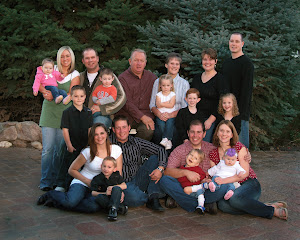Once a month I make a Family Home Evening Lesson
to share with those who are in my church. I thought others may benefit from this, too. I apologize to those in my church who may have already used this lesson. Here it is:
LESSON IDEA:“The Responsibility of Choice” Please adjust lessons to age, time & needs of your family members.
Hymn #240, “Know This, That Every Soul Is Free”
Scriptures to Reference: Moses 4:1, 3; Moses3:15-17; Moses 5:15.
David O. McKay said the above “three passages demonstrate three fundamentals of life. First, that the Lord considered man’s free agency, his right to choose, so vital that he permitted what is referred to as a war in heaven; so vital that those who were with him in the spirit world had their choice to follow the dictator, known as the Evil One.
“The second was the privilege that those first parents had to take upon themselves mortality. You may choose, but remember, if you choose to take upon yourselves that mortality referred to as The Fall, then you shut yourselves out from his presence and you ‘shall surely die.’
“Third, Adam heard the voice of God ‘toward the garden.’ And the Lord gave him commandments, and said: ‘Offer unto me (Unto God) the firstlings of your flocks,’ and by inference we conclude ‘the best that you raise in the garden and the field.’ See what that means in developing spirituality? The first of the flock is the most luscious, the most tender, the best fleece. Selfishness, the animal nature, would say, ‘I want that,’ but God, knowing that the highest purpose of man is to develop the spirit within him, said, ‘Give the firstlings to God, thinking not of self, but of something higher.’ What a sublime purpose! What an essential purpose! It was as if the Lord said: ‘You who live in the earth need the experience to know good from evil, and to live not for yourself but for God. Whatever you do, do in his name. Therein is glimpsed the whole purpose of life.’” (Stepping Stones to an Abundant Life, pp 47-49.)
Goethe said, “Life is a quarry, out of which we are to mold and chisel and complete a character.”
We can choose but we must always remember, “For inasmuch as ye do it unto the least of these, ye have done it unto me.” (D&C 42:38) We can choose:
1) Selfishness or we can deny ourselves for the good of others.
2) Indulgence of appetite, passion, or we can develop restraint & self-control.
3) Licentiousness or chastity.
4) We can encourage hate or develop love.
5) We can practice cruelty or we can be kind.
6) We can be cynical or we can be sanguine—hopeful.
7) We can be traitorous—disloyal to those who love us, to our country, to the Church or to God or we can choose to be loyal.
8) We can be deceitful or we can be honest and have “our word be our bond.”
9) We can be slanderous or we can control our tongue.
No matter what problem you face in your daily life, always remember:
You are the person who has to decide
Whether you’ll do it or toss it aside.
You are the person who makes up your mind
Whether you’ll lead or will linger behind
Whether you’ll try for the goal that’s far
Or just be contented to stay where you are.
Whatever it is you are wanting to be,
Remember, to fashion the choice you are free.
Kindly or selfish, or gentle or strong,
Keeping the right way or taking the wrong,
Careless of honor or guarding your pride, All these are questions which you must decide.
Yours the selection, whichever you do;
The thing men call character’s all up to you.
(author unknown)
At this point in the lesson, you might ask family members if the world would be a better place if everyone tried to live the above 9 positive sides of the choices listed. If they can see that doing good to others, having self-control, being chaste, kind, etc. would make the world a better place, you can bear testimony that these things are true and right because the world would be a better place and our Father in Heaven and Jesus would be very pleased.
Refreshment idea: Make two or three desserts for family members to choose from. Tell them they can only choose one. Make all desserts look nice but make one particularly attractive and appealing. In this dessert add salt instead of sugar. Then, when one or all family members eat this, point out that they chose it. Make the comparison that there are always choices to be made in life and often the things that seem to be the funnest, most adventurous, most beautiful, etc. can be very appealing. One must be prayerful and cautious and look for possible consequences for choices that face them. A guide might be to ask themselves: “What would Jesus do?” “Would my choice help make the world a better, safer place?”
Guide for Responsible Decision Making1- Define the problem.
2- Explore the alternatives.
3- Apply criteria for responsible decision making to each alternative:
***Would the results of my decision be healthful?
***Would the results of my decision be safe?
***Would the results of my decision be legal?
***Would the results of my decision show respect for others?
***Would the results of my decision follow my parent’s or guardian’s guidelines?
4- Identify values.
5- Make a prayerful, responsible decision and act upon it.
6- Evaluate your actions.
A CHANCE FOR THE FAMILY TO INTERACT:Prepare in advance:
A Pot of soup or stew.
Attach spoons to arm-length dowels or get enough arm-length wooden spoons for each family member. Be prepared to attach a spoon to each family member’s arm by tying or taping the spoons above the elbow and on the forearm thus making it impossible to bend the elbow (You’ll understand why in a minute).
Read the following story so that you can understand the purpose for the long spoons.
Without telling family members the story, invite them to eat their soup or stew. Have fun with this. Take pictures, laugh, enjoy.
Later, you can share the story if needed. And if there are those that never thought of helping each other, assure them that that’s why we are still on earth—to learn from our experience. Ask them what they might do to assure that if a similar experience occurs in a real-life situation, that they will “think” to put others before themselves.
STORY (author unknown): A man had a dream that he had a conversation with the Lord and he asked, “Lord, I would like to know what Heaven and Hell are like.” So, the Lord led the man to two doors.
He opened one of the doors and the man looked in. In the middle of the room was a large round table. In the middle of the table was a large pot of stew which smelled delicious and made the man’s mouth water.
The people sitting around the table were thin and sickly. They appeared to be famished. They were holding spoons with very long handles that were strapped to their arms and each found it possible to reach into the pot of stew and take a spoonful. But, because the handle was long and attached to the length of their arms, they could not get the spoons back into their mouths.
The man shuddered at the sight of their misery and suffering.
The Lord said, “You have seen Hell.”
The Lord led the man to the next room and opened the door. Everything in the room appeared to be the same. There was the large round table with the large pot of stew which made the man’s mouth water. The people were equipped with the same long-handled spoons, but here the people were well-nourished and plump and they were laughing and talking. The man turned to the Lord and said, “I don’t understand.”
“It is simple,” said the Lord. “It requires but one skill. You see they have learned to feed each other, while the greedy think only of themselves.” Again, it’s all about CHOICE!
Ask yourself: Which position would I find myself in? Remember, when Christ died on the cross, he was thinking of you. Remember, “I will always share my spoon with you.”
Lazy Lady Stew2 lbs. cubed stew meat
10 oz. pkg. frozen peas or 16 oz can of tiny peas
1 C sliced carrots
2 onions, chopped
2 potatoes, pared and sliced
1 tsp. salt
Dash of pepper
1 can cream of tomato soup
1/2 soup can water
1 bay leaf
Serves 4: Mix all ingredients in a large casserole. Cook, covered, in a 275 degree oven for 6 hours. The stew meat can be put in frozen, but increase the cooking time by 1 hour. Not only is this stew delicious, but it is unbelievably easy. Serve with Home Style Cornbread and a green salad. (You can easily double or triple these proportions and feed a crowd.)
Home Style Cornbread1 C yellow cornmeal
1 C flour
1/4 C sugar
4 tsp. baking powder
1/2 tsp. salt
1 C milk
1 egg
1/4 C vegetable oil
Make 1 dozen muffins, 14 corn sticks or 1 8-inch square pan: Mix cornmeal, flour, sugar, baking powder and salt. Add milk, egg and shortening and beat until smooth. Pour into greased or lined muffin tins, or corn stick pans and bake at 425 degrees 15-20 minutes. It can also be baked in a greased 8-inch square pan at 425 degrees for 20-25 minutes.













